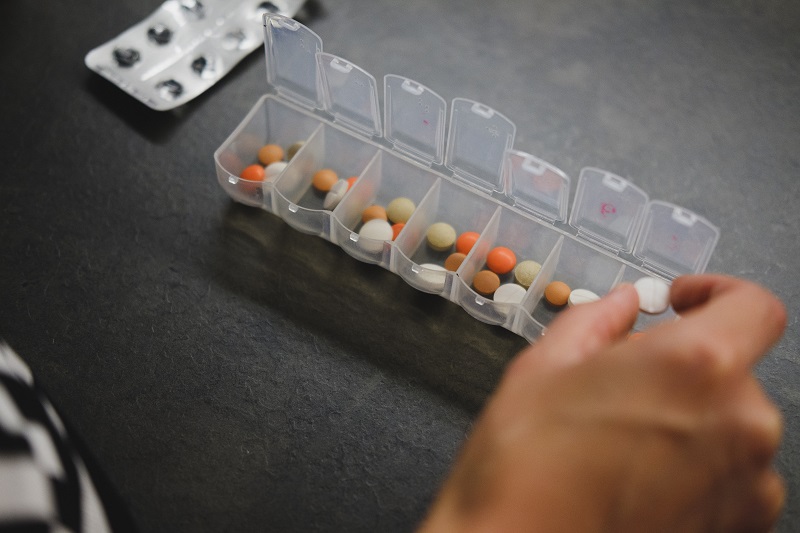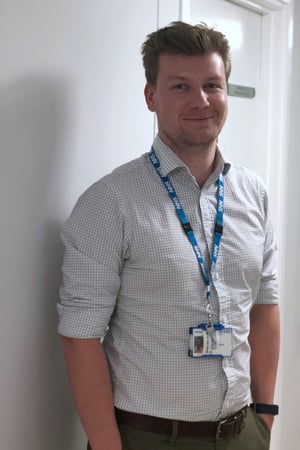Share this
AKU, NTBC, and VAMS®: fighting a rare metabolic disease
by Neoteryx Microsampling on Aug 15, 2019 5:51:00 AM
 The Challenge of AKU
The Challenge of AKU
Alkaptonuria, or AKU, is a rare and less-studied inherited metabolic disorder. It results from a deficiency of homogentisic acid dioxygenase (HGD), part of the tyrosine degradation pathway. As of yet, there is no cure. However, The National Centre for Alkaptonuria, hosted by The Royal Liverpool and Broadgreen University Hospitals, is supporting international clinical trials that may help change that. And clinical chemist Joseph Taylor says that Volumetric Absorptive Microsampling technology and Mitra® devices already play an important role in the relevant drug development process.
"As we receive samples from all over the world, and patients who often have physical disabilities must sometimes travel extensively for sample collection, there was interest in the ability of microsampling to alleviate logistical, financial, and patient-experience-related concerns," says Taylor. "Mitra® was chosen as it offers benefits over traditional dried blood spot, or DBS, sampling, which was being used for monitoring of select patients but was felt to limit service quality."
Using the right technology matters when the stakes are this high. When the metabolic function of HGD is lost, homogentisic acid (HGA) accumulates as a black ochronotic pigment in bone, cartilage, and other collagenous tissues. These tissues become brittle, leading to searing pain and severe physical disability. Current treatment regimens using analgesia and anthroplasty are of only limited effectiveness, but a drug known as nitisinone (NTBC) is giving hope to researchers and patients.
The Promise of NTBC
NTBC inhibits an enzyme upstream from HGD and blocks the formation of HGA, which can theoretically stop the deposition of pigment. Two major clinical trials have already been completed. Proper drug monitoring is crucial. "As NTBC is not currently licensed for use in AKU treatment, patients receiving this off-license or as part of a clinical trial require regular biochemical monitoring of relevant blood and urine metabolites and drug levels," Taylor says. "As a result of its action, NTBC causes significantly elevated levels of tyrosine within the blood, which must be monitored and controlled via a low-protein diet to prevent clinical manifestations of hypertyrosinaemia, such as keratopathy."
With so much on the line, it helps to have the right tools. Fortunately, Taylor and his team have found that using Mitra devices with absorbent VAMS® tips for this work has been convenient and rewarding, helping the research along by freeing up energy and bandwidth. "It is nice to work with a device that is so elegant in concept and design, easy to use for both laboratory staff and patients, and still offers robust performance," Taylor says. "This allows more focus to be given to other areas, such as analytical method optimization, rather than worrying about sample quality as with traditional microsampling approaches... I also know firsthand that our patients' experiences with Mitra® devices have also been positive, with those asked naming Mitra®, exclusively, as their preferred sampling method."
Sampling Multiple Matrices
 Taylor and his research team evaluated Mitra® for both urine and blood. The work with urine is published, while publication is pending for the work with blood. The technology proved suitable for both, and each is essential in its own way. “Urine analysis is important as urine HGA is used for initial diagnosis; it should be virtually undetectable in non-AKU individuals,” Taylor says. “Reduction in urinary HGA excretion was also one of primary outcomes used to prove the metabolic efficacy of NTBC in clinical trials… Even with the requirement for refrigeration, Mitra® removed the need for sample acidification and dry ice which has logistical and cost benefits.”
Taylor and his research team evaluated Mitra® for both urine and blood. The work with urine is published, while publication is pending for the work with blood. The technology proved suitable for both, and each is essential in its own way. “Urine analysis is important as urine HGA is used for initial diagnosis; it should be virtually undetectable in non-AKU individuals,” Taylor says. “Reduction in urinary HGA excretion was also one of primary outcomes used to prove the metabolic efficacy of NTBC in clinical trials… Even with the requirement for refrigeration, Mitra® removed the need for sample acidification and dry ice which has logistical and cost benefits.”
When using Mitra® devices to collect blood samples, Taylor found it to be a more practical and reliable alternative to DBS cards. “Some patients were being monitored using DBS, but as we did not have an in-house method for DBS analysis, this was done by a referral laboratory,” says Taylor. “This increased costs and delayed the receipt of results on which patient management decision would be based. There was also a relatively high sample rejection rate for DBS due to poor quality specimens, again increasing costs and turn-around-times, and being inconvenient for patients due to repeat sampling. Mitra® does not suffer from these issues, and consistently collects high quality samples.”
What’s Next?
The broader implications of this work are encouraging, including evidence to support Mitra® for monitoring of other hereditary metabolic diseases such as phenylketonuria and type 1 tyrosinaemia, the latter of which is also treated using NTBC. "Closer to home, demonstration of device performance and incorporation into routine workflows within current services has been used as a proof of concept exercise, with other AKU and non-AKU related projects now in the works within my organization," says Taylor.
While Mitra® devices make a big difference, what really drives research such as this is the initiative and enthusiasm of the people who use them, of which Joseph Taylor is a sterling example. "I really enjoy working on translational projects and applying novel technologies to real-world problems and service-improvement initiatives," he says. "Working in clinical, it is important to always remember the patient within the pathway and the importance of their experience, and I am proud to work on projects which acknowledge this and drive service development with a patient-focused approach."
Ready to make your own breakthrough with Mitra®? Reach out to a Neoteryx Microsampling Specialist today to get moving.

Share this
- Microsampling (206)
- Research, Remote Research (119)
- Venipuncture Alternative (105)
- Clinical Trials, Clinical Research (83)
- Mitra® Device (73)
- Therapeutic Drug Monitoring, TDM (51)
- Dried Blood Spot, DBS (39)
- Biomonitoring, Health, Wellness (30)
- Infectious Disease, Vaccines, COVID-19 (24)
- Blood Microsampling, Serology (23)
- Omics, Multi-Omics (21)
- Decentralized Clinical Trial (DCT) (20)
- Specimen Collection (18)
- Toxicology, Doping, Drug/Alcohol Monitoring, PEth (17)
- Skin Microsampling, Microbiopsy (14)
- hemaPEN® Device (13)
- Preclinical Research, Animal Studies (12)
- Pharmaceuticals, Drug Development (9)
- Harpera Device (7)
- Industry News, Microsampling News (5)
- Antibodies, MAbs (3)
- Company Press Release, Product Press Release (3)
- Environmental Toxins, Exposures (1)
- July 2025 (1)
- May 2025 (1)
- April 2025 (2)
- December 2024 (2)
- November 2024 (1)
- October 2024 (3)
- September 2024 (1)
- June 2024 (1)
- May 2024 (1)
- April 2024 (4)
- March 2024 (1)
- February 2024 (2)
- January 2024 (4)
- December 2023 (3)
- November 2023 (3)
- October 2023 (3)
- September 2023 (3)
- July 2023 (3)
- June 2023 (2)
- April 2023 (2)
- March 2023 (2)
- February 2023 (2)
- January 2023 (3)
- December 2022 (2)
- November 2022 (3)
- October 2022 (4)
- September 2022 (3)
- August 2022 (5)
- July 2022 (2)
- June 2022 (2)
- May 2022 (4)
- April 2022 (3)
- March 2022 (3)
- February 2022 (4)
- January 2022 (5)
- December 2021 (3)
- November 2021 (5)
- October 2021 (3)
- September 2021 (3)
- August 2021 (4)
- July 2021 (4)
- June 2021 (4)
- May 2021 (4)
- April 2021 (3)
- March 2021 (5)
- February 2021 (4)
- January 2021 (4)
- December 2020 (3)
- November 2020 (5)
- October 2020 (4)
- September 2020 (3)
- August 2020 (3)
- July 2020 (6)
- June 2020 (4)
- May 2020 (4)
- April 2020 (3)
- March 2020 (6)
- February 2020 (3)
- January 2020 (4)
- December 2019 (5)
- November 2019 (4)
- October 2019 (2)
- September 2019 (4)
- August 2019 (4)
- July 2019 (3)
- June 2019 (7)
- May 2019 (6)
- April 2019 (5)
- March 2019 (6)
- February 2019 (5)
- January 2019 (8)
- December 2018 (3)
- November 2018 (4)
- October 2018 (7)
- September 2018 (6)
- August 2018 (5)
- July 2018 (8)
- June 2018 (6)
- May 2018 (5)
- April 2018 (6)
- March 2018 (4)
- February 2018 (6)
- January 2018 (4)
- December 2017 (2)
- November 2017 (3)
- October 2017 (2)
- September 2017 (4)
- August 2017 (2)
- July 2017 (4)
- June 2017 (5)
- May 2017 (6)
- April 2017 (6)
- March 2017 (5)
- February 2017 (4)
- January 2017 (1)
- July 2016 (3)
- May 2016 (1)
- April 2016 (2)


No Comments Yet
Let us know what you think